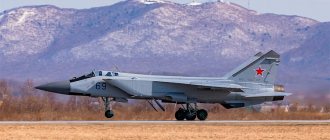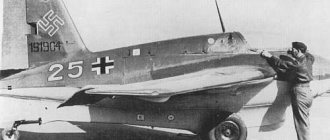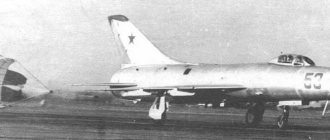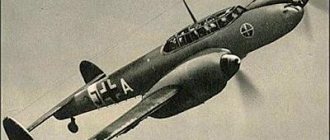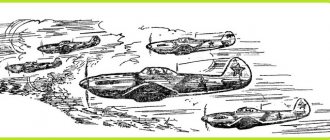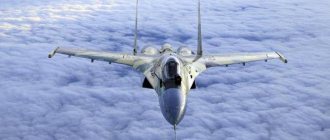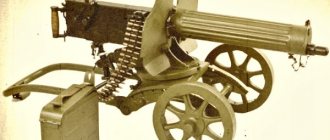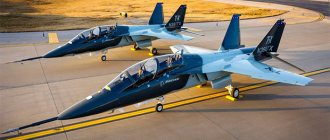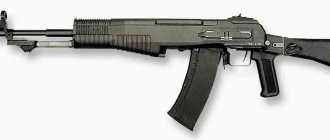In 1968, Mikoyan's design bureau received a government order to develop a new fighter-interceptor capable of solving numerous problems facing the USSR Air Force due to the growing tension of the international situation.
Increasing cases of violation of the air borders of the Soviet Union by the latest aircraft required drastic measures. The engineers of the Mikoyan Design Bureau began the task, not knowing that on their drawing boards one of the best aircraft in the country would be born - the MiG-31 aircraft.
History of the creation of the MiG-31 fighter
The military set the engineers tasks that required a fundamentally new solution. The air defense system needed a multi-purpose vehicle capable of not only combating potential enemy aircraft, but also resisting missiles of various classes.
Moreover, according to the technical specifications, the interceptor had to have a sufficiently large range of action to reliably cover the protected area. Initially, many design decisions met with resistance from conservative military pilots and some engineers.
The greatest problems awaited the designers when fulfilling the task of placing weapons control systems in the hull of the new aircraft, as well as the on-board radar (radar station) “Zaslon”.
In 1969, instrument engineers from the Research Institute named after. Tikhomirov proposed an unexpected solution to this problem, presenting a revolutionary device at that time, the placement of which was considered a gamble.
A fundamentally new phased antenna array (PAR) was developed for the aircraft. The project manager, Air Marshal Savitsky, risked everything by agreeing to test the experimental device. But his hopes, as well as the hopes of all participants in the creation of the FAR, were justified.
In parallel, development of the R-33 missile was underway, which was to become the main weapon of the MiG-31.
Strict conditions were imposed on the designers:
- Hitting a target with a product at long range
- Light weight of the finished product
The assets of the future aircraft included at least 4 such aircraft missiles. Tests of the R-33 were completed simultaneously with the Zaslon in 1981, after which the vehicle finally entered service. At that time, the MiG-31 had already been in mass production for 2 years.
Interesting fact. Work on the creation of an interceptor accelerated after pilot Belenko escaped to Japan in a MiG-25 in 1976. The model, which had been dismantled down to the smallest components by the Americans, had to be quickly discontinued from production, and the MiG-31 interceptor fighter, which was being modified, would soon be put into service.
The new model was the first Soviet fighter of the 4th generation and was head and shoulders superior to both the MiG-25 and similar machines of the potential enemy. According to NATO classification, the interceptor was nicknamed "Foxhound" - a breed of dog known for its high speed and endurance.
Interceptor fighter design
The appearance and design of the MiG-31 aircraft was seriously influenced by one of the best aircraft of that time - the MiG-25, which was discontinued due to Belenko's escape. Structurally, the 25th had enormous potential for development.
It was used by the designers of KB-155, who developed the MiG-31 as a basis.
Main characteristics of the interceptor design:
- trapezoidal wing located in the upper part of the body
- all-moving stabilizer
- normal aerodynamic design
- “branded MiG” two-keel tail of the vehicle.
The MiG airframe also received major changes affecting the alloys used for the hull. 50% was stainless steel versus 80% for the MiG-25. 33% were made from aluminum-based alloys, 16% of the case was made from titanium, 1% from other materials. This layout made it possible to significantly reduce the weight of the airframe, making it possible to use the lifting capacity resource to greater advantage.
The design of the vehicle included a large number of fuel tanks. In total, the design contained 17,330 kilograms of fuel, distributed between 7 tanks in the fuselage, 5 tanks in the wings and 2 keel tanks. If necessary, additional tanks are suspended under the wings, 2 containers of 2500 liters each.
An important change was the installation of a gargrot in the middle part of the fuselage, on top. This provided advantages both in protecting vital control elements and in streamlining the fuselage. By the way, the controls on board are mechanical, and the garrot perfectly protects the rigid rods and wiring on this machine.
However, the 31st also had some differences from its predecessor. Thus, some of the stainless steel parts on the body were removed from the new interceptor. This was due to a decrease in heating in the power part of the fuselage body.
In addition, the MiG-25 was a single-seat aircraft, while the 31st received, in addition to the pilot, also a navigator-operator, who was located behind the pilot.
Connected with this is a joke popular among pilots that after Belenko’s flight, a “special officer” will accompany the pilot on each flight. Of course, this is just a joke.
The new car had sophisticated radio equipment, which would be difficult to handle alone. The navigator-operator performed the tasks of monitoring space in the air and, using instruments, developed tactical techniques necessary to intercept and destroy group targets.
Range of flight
The flight range of the Mig-31 largely depends on the amount of fuel on board, the weight of the payload and the flight speed of the aircraft. At subsonic speed without missiles, the flight range can be about 2500 km. In this case, the flight duration will be 2.5 hours.
With four missiles and their launch in the middle of the range, the range will be 2400 km, with four missiles and launch at the end of the range, the range will be 2240 km.
With two drop tanks and their release after fuel consumption, the aircraft will be able to fly 3,000 km. The Mig-31 will achieve the same flight range with a single replenishment of fuel in the air from a special tanker aircraft. The aircraft's maximum flight range of 8,000 km was obtained with three replenishments of fuel from a tanker aircraft. The flight duration took about 7 hours.
The range of the Mig-31 during combat operation is over 700 km.
Chassis and braking system
The design of the MiG-31 fighter chassis also deserves special attention.
The board lands on a three-post structure. The front chassis is reinforced with two pneumatic mechanisms and consists of two wheels measuring 660x200 mm.
An important difference from the MiG-25 is that the front landing gear is now retractable. The side landing gear located in the lower part of the fuselage is made in the form of two-wheeled trolleys.
The wheel size is 950x300 mm, they move forward. An interesting solution is that the landing gear brake flaps simultaneously serve as flaps.
The MiG-31 chassis allows this vehicle to land on any runway of acceptable quality. Ice or soil, of course, is not the best runway for an interceptor fighter, but it is capable of being based at such airfields.
This is extremely important in the operating conditions of the 31st in sparsely populated areas of Siberia and the Far East, which are not spoiled by infrastructure.
The design also includes a container with a braking parachute at the rear of the fuselage.
Engine and speed potential
The power plant of the device is represented by two D-30F6 engines. This sample is double-circuit: the inner and outer circuits mix the flows behind the turbine.
The characteristics of each of the two engines impress even competitors of the 5th generation fighters:
- 9270 kgf non-afterburning thrust at maximum capabilities;
- 15510 kgf similar afterburner thrust
- 2420 kg dry weight.
The engines allow the sample to reach a maximum speed of about 3000 km/h. This indicator is the best among similar aircraft of domestic and foreign production.
But the main surprise is that it is capable of developing supersonic speeds not for a short time (for example, 15 minutes for the Su-35), but for a time literally limited by fuel reserves. Taking into account the fact that an L-shaped bracket has been developed in the nose for in-flight refueling, the sample has inexhaustible potential.
Russian pilots set a record for being in the air with this aircraft. It took 7 hours 4 minutes, covering 8000 km, which is nonsense for fighters.
Main technical characteristics of the aircraft
The interceptor is designed as a monoplane with a high-mounted wing. It has two vertical keels and two horizontally located engines in the tail section. The wing is in the shape of a trapezoid. The engine air intakes are located on the sides of the fuselage, just behind the cockpit. The Mig-31 cabin is designed for two crew members.
In the manufacture of the Mig-31 structure, mainly high-strength and high-temperature steel was used, the remaining elements were titanium and aluminum alloys. For the first time in the domestic aircraft industry, a combat vehicle was equipped with a phased array antenna locator. The aircraft's power plant uses turbojet engines with two circuits and a high compression ratio.
The aircraft is capable of flying at speeds several times higher than the speed of sound and withstanding overloads of up to 5 g. On later modifications of the aircraft, equipment for in-flight refueling was installed.
Main technical characteristics of the Mig-31:
Some performance characteristics of the Mig-31 are superior to those of modern aircraft.
Cabin equipment
The navigator-operator is equipped with advanced electronic devices, the likes of which are unique in almost all similar aircraft in the world. The tactical situation and navigation equipment are broadcast on a large indicator. Thus, the operator is able to monitor all possible situations in the sky.
A color indicator is mounted in front of the pilot, displaying virtually every aspect of the aircraft's technical data in flight. Scales, indices, and benchmarks provide a comprehensive analysis for further actions of the crew.
For the safety of pilots, ejection seats are installed. Unfortunately, they are sometimes vital.
There have been several crashes with aircraft of this series for various reasons. And fortunately, the ejection system saved the lives of the pilots.
Fighter weapons
The model is perfectly armed to carry out the tasks assigned to it.
The combat kit of the aircraft includes:
- 23-mm 6-barreled gun GSh-6-23 with 260 rounds of ammunition and a rate of fire of 8,000 rounds/minute
- 4 guided missiles (UR) type R-33, long-range. The missile range increased from 120 km (1981 model) to 304 km (2012 model)
- 2 medium-range guided missiles R-40T. The range depends on the model and varies from 80 to 110 km.
- 4 short-range guided missiles R-60, R-60M and R-73
- possibility of using bombs with laser target designation
- The combat load, depending on the type and model, varies from 3000 to 9000 kg.
The Zaslon radar allows the use of missiles with the greatest efficiency. The system detects a strategic bomber of a potential enemy at a distance of 200 km, and an escort fighter at a distance of 120 km.
The ability to capture small objects against the background of the earth has been implemented - this makes it possible to destroy not only guided aircraft, but also cruise missiles. The system ensures reliable target destruction by a guided missile at maximum distances.
At the same time, “Barrier” makes it possible to capture and lead up to 10 targets simultaneously, while attacking 4 targets with UR.
Aircraft missiles are placed in the lower part of the fuselage and under the wing consoles on recessed pylons, without disturbing the aerodynamics of the fighter. The GSh-6-23 cannon is located in the lower part of the fuselage. To improve aerodynamic qualities in a non-combat position, it is hidden under the fairing flap.
Power point
The Mig-31 power plant includes two turbojet forced aircraft engines with two compression circuits, each with a normal thrust of about 9 tons and an increased thrust of about 16 tons. This aircraft engine was created by designers and engineers of the design bureau from Perm. Main engine parameters:
The Mig-31 engine has in its design several staged low and high pressure compressors, which compress the air with great force before supplying it to the combustion chamber. Fuel is injected there, into the combustion chamber. The resulting air-fuel mixture burns at a temperature of about 1400 degrees. The gases escaping from the engine nozzle are capable of pushing the aircraft with a force of about 10 tons.
The total thrust of the twin Mig-31 installation can reach from 20 to 30 tons. The amount of air entering the engine is controlled using special devices depending on the altitude and flight speed. This ensures stable engine operation at all altitudes. The diameter of the supersonic engine nozzle exit section can be adjusted. Which increases or decreases the speed of gases leaving the engine nozzle and, thus, regulates its thrust.
The Mig-31 engine has a high degree of reliability, which is ensured by special protection against uncontrolled spin-up of engine parts, limitation of its heating, as well as timely detection of defects and damage to its mechanisms and individual parts. Increased reliability is also achieved by duplicating individual motor systems.
The design of the Mig-31 aircraft engine has a high degree of maintainability, which is largely due to the modular design of the engine.
Modifications
Work on this project was not completed after the MiG-31 was put into service; the potential was too great. Electronics did not stand still; designers were given new, more complex tasks.
Therefore, after a few years, various modifications were developed, namely:
- MiG-31M - this model was released in 1993. Unlike the main model, this one had enhanced weapons and electronics. Many minor changes and improvements were made to improve the quality of the sample, but it never went into production;
- The MiG-31B , a variant in mass production since 1990, was for the first time equipped with an in-flight refueling system;
- MiG-31BM is an aircraft modernized for the Russian Air Force in 1998, and is currently the most advanced production model of this line of aircraft;
- The MiG-31D , a single-seat version capable of fighting potential enemy satellites using 79M6 Kontakt missiles, also did not go into production;
- MiG-31I – adapted to deliver small spacecraft for various purposes into orbit from 600 to 300 kilometers;
- MiG-31LL is a flying laboratory assigned to one of the research institutes of the city of Zhukovsky, the main city of Russian aviators;
- The MiG-31F is a fundamentally new machine of this series, designed as a front-line fighter designed to attack ground targets and directly support ground forces.
Aircraft prospects
Taking into account the unique flight characteristics and combat capabilities of the MiG-31, work continues on its further modernization. This is mainly due to the improvement of on-board equipment and electronics, as well as engine capabilities. The aerodynamics of the aircraft, combined with the materials from which the aircraft was made, proved to be a distinct advantage even over later fighter aircraft designs. Some characteristics of the Mig-31 remain unsurpassed to this day. In the near future, it is planned to upgrade 60 MIG 31 fighters to the BM level, and plans to resume production of the Mig-31 are being considered in government circles and the Russian State Duma.
Exploitation
The aircraft has been in service since 1981. Before the collapse of the USSR, they managed to create about 500 units. Most of them were located on Russian territory, some were transferred to the Kazakh Air Force. Since its adoption, this machine has become a real headache for flying reconnaissance aircraft of NATO countries flying over the territory of the Soviet Union.
Before this, no interceptor could compete with American pilots. The new interceptor was superior to the machines that illegally flew over the territory of the USSR, as a result they had to curtail these flights. The ability of the MiG in question to shoot down satellites also influenced the flight missions of reconnaissance vehicles.
The 31st were almost never used in modern local wars, since the type of design was “tailored” specifically to intercept aircraft and missiles, which were not used either in Afghanistan or in Chechnya by opponents of the Soviet and then Russian armies. During the Second Campaign in the Chechen Republic, a pair of four MiGs were on duty, but they only carried out radar reconnaissance. In the skies of Syria, four MiG-31s guard the approaches to the Khmeimim airbase, but are not directly fighting ISIS, which is banned in Russia.
In addition to protecting the sky above the base, MiGs support and replace radar reconnaissance vehicles, and also coordinate the actions of Russian aviation, thereby protecting the famous A-50. The specificity of the interceptors and their fantastic indicators of combat effectiveness led to the fact that the units of equipment of the brand in question were transferred to the rank of special forces.
In addition, the 31st is actively used in the skies of the Far East and Siberia. The chassis features, which allow the aircraft to be used on runways of different types and quality, make it indispensable in permafrost and harsh weather conditions that negatively affect the runways of the above-mentioned territories.
In addition, the ability to remain in the air for a long time and the wide range of the radar makes it possible to keep the vast sky in eastern Russia under control.
However, the prospects for the 31st are not at all joyful. Since 1994, this model has not been produced either at the Nizhny Novgorod Sokol or anywhere else in Russia. Now there are 247 vehicles left in service, their resource is gradually being used up. In 2013, it was reported that 80% of units of this brand are in need of serious repairs. In the government and circles associated with the Ministry of Defense, there are increasingly persistent demands to resume production of a unique device, the likes of which will not exist in the world for the next 10-15 years.
Almost all the resources are available to create new machines, including about 600 engines mothballed at the Perm Machine-Building Plant. But the controlling stake in this enterprise is in the hands of American investors, who, logically, are not eager to produce such a device for the Russian military space forces.
In conclusion, we can say that the MiG-31 was and remains one of the best aircraft of the Russian Aerospace Forces, whose technical characteristics are at the highest level of world aviation, and the modernization resource is far from being fully developed.
